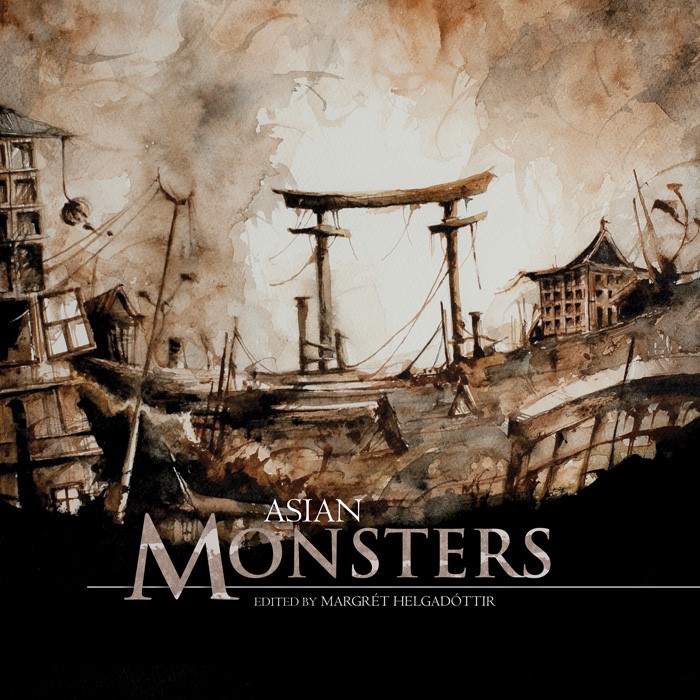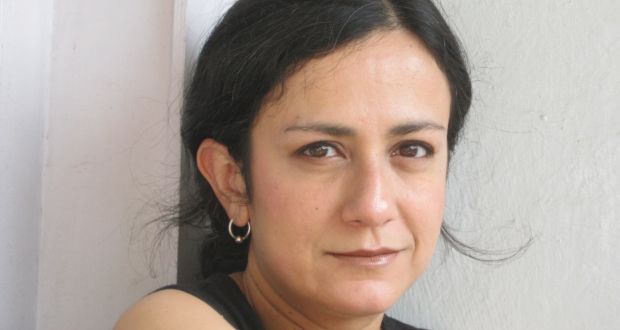Here be Monsters! They lurk and crawl and fly in the shadows of our mind. We know them from ancient legends and tales whispered by the campfire. They hide under the dark bridge, in the deep woods or out on the great plains, in the drizzling rain forest or out on the foggy moor, beneath the surface, under your bed. They don’t sparkle or have any interest in us except to tear us apart. They are the monsters! Forgotten, unknown, misunderstood, overused, watered down. We adore them still. We want to give them a renaissance, to reestablish their dark reputation, to give them a comeback, let the world know of their real terror.
Asian Monsters is the third in a coffee table book series from Fox Spirit Books with dark fiction and art about monsters from around the world. It’s edited by Margret Helgadottir. It features the authors Xia Jia, Ken Liu, Eve Shi, Usman T. Malik, Aliette de Bodard, Isabel Yap, Benjamin Chee, Eliza Chan, Eeleen Lee, CY Yan, Fran Terminiello, Sunil Patel, Yukimi Ogawa and Vajra Chandrasekera, and the artists Dave Johnson, Cindy Mochizuki, Vincent Holland-Keen, Kieran Walsh and Imran Siddiq. Cover art is by Daniele Serra.
Tell us more about your own journey as a writer. Where did it all begin?
SP: It all began with The Disastrous Dino War, as far as I can remember. When I was about 7, I wrote and illustrated a book for a contest called, as you might expect, Written and Illustrated By. I have no memory of what inspired me to want to be a writer, but as I grew up, I kept writing, though mainly for contests or classes. Then in college, I took several creative writing courses, which forced me to produce more work in three years than I’d produced in my whole life before. After grad school, I found a creative outlet in theater, but it wasn’t until attending the World Science Fiction Convention in San Antonio in 2013 (LoneStarCon) that I decided to actively pursue my dream of becoming a published writer. Until then, it hadn’t even occurred to me that I could write and publish genre fiction since I didn’t understand how the market worked, but now the veil was lifted.
UM: I’ve been closet-writing since I was 10 years old and wrote several unpublishable stories in my native tongue Urdu before I was thirteen. I even gained something of a pulp writer status in grade six when my series of handwritten connected stories about a telepath secret spy began to circulate in class with a readership of . . . four. I don’t remember why I stopped writing those. They’re probably still sitting around in a journal somewhere in my house.
What excites you most about genre writing?
SP: I love the limitless possibilities available when you’re not restricted to the real world. You can create any world your imagination desires, not to mention any character. And the best part is that genre writing has the ability to reflect the real world in clever ways, hiding deep human truths in stories about dragons or insightful political commentary in a conflict between warring robot factions. You can take a reader anywhere, but the reader will always bring their own personal experiences and viewpoints to that imaginary world. Even though genre writing is considered escapist, it’s often the best place to confront the things you’re trying to escape.
UM: I’ve loved imaginative stories all my life and was a voracious reader of books in two languages. As a kid I disliked realist allegorical stories and much preferred stories with magic, supernaturalism, darkness, or thought experiments. That preference continues, although I tend to vacillate between plot and prose these days, sometimes word-hungry, sometimes just wanting a good old page-turner. Genre works at least in English continue to diversify in theme, narrative vehicles, global inclusivity, and literary aesthetic; they become increasingly more relevant and satisfying for a variety of readership as the crossover between the so called ‘literary’ and ‘genre’ worlds continues. I think that’s exciting and enriching.
Tell us a little bit about your piece in the collection and what inspired you to write it?
SP: As a kid, I loved reading the stories of the Baital Pachisi in comics and watching the Vikram aur Betaal television program. As an adult, I appreciated how writers like Shveta Thakrar and Roshani Chokshi took elements from Indian culture and folklore and put their own spin on them. I knew that I wanted to one day write a story about vetalas, specifically a modern take on the classic tale of Vikram and Betaal. I was delighted to be asked to write a story for Asian Monsters, but my Vikram and Betaal story would be lighter than Margret wanted. So I needed a more horrific angle, and what’s more horrific than opening the door to see your dead, maimed father walking and talking because his corpse has been possessed by a vetala? I found very little information on vetalas, which meant I was free to come up with my own interpretation for the story, and what always drew me to Betaal, the most famous vetala in literature, was his penchant for telling moralistic stories. I wondered what would happen if there were two vetalas telling two stories. With one tormented daughter in the middle. This is a story about guilt and justice, not to mention the fluidity of memory and our capacity for self-deception. Also gulab jamun cupcakes. While there is some blood and gory imagery in “The Vetalas’ Query,” it’s more psychological horror than anything else.
UM: I have this memory–I don’t know whether it’s real or fictitious–of overhearing an uncle telling my father of his trip to Murree, a mountain town in Pakistan. He was driving through snow, he said, and was stopped by these women who asked for a donation of human blood. Later, my cousins and I passed this story around like a childhood disease, ever garnishing the details. “Blood Women” was the product of that and some political events in Pakistan in the last decade or so.
What do you think it will take for Asian genre writers to break through to the mainstream?
SP: Eliminate systemic racism and centuries of prejudice! Barring that, Hollywood could lend us a hand by noticing we exist and not whitewashing our stories. It’s no secret that having a movie made of your book sells copies of that book, so I’m happy about the success of Arrival, based on a story by Ted Chiang, and the recent news that Ken Liu’s Dandelion Dynasty is set to become a film franchise. Wesley Chu’s Time Salvager is going to be a movie directed by Michael Bay, and you can’t get much more mainstream than that. The more Hollywood diversifies its properties, the better it is for everyone. The more we’re represented onscreen and offscreen, the more mainstream audiences begin to see us as, well, people, rather than Other. It’s one tiny step toward influencing readers to consider Asian genre writers when they’re choosing what to read. Meanwhile, sites like Nerds of Color—and, of course, The Asian Writer!—will continue to speak up and make sure Asian writers have a voice.
UM: I think they already are, although the process seems slow. They tend to do better in the western world if they’re jumping off a ‘mainstream’ platform and are writing in the tradition of others before them such as Bapsi Sidhwa, Murakami, Arundhati Roy, Khalid Husseini, or Salman Rushdie. There is an audience, western publishers believe correctly, for such writers and fictions. However, that’s changing too. Asian genre writers who define themselves as genre are increasingly finding a global audience that appreciates an imaginative well written story.
Which writers would you say have had the most influence on your work?
SP: The first name that always comes to mind is Joss Whedon because my work also tends to have a strong emotional core and witty banter, some lightness to balance the dark. Television and film influence my work quite a bit, maybe moreso than books. It’s hard to cite specific writers, however, since I try not to write the same thing twice. Certain stories I can clearly point to as my attempt to write a John Scalzi story or a Sofia Samatar story, for instance. In my college creative writing courses, I found a literary idol in Lorrie Moore, whose dry humor and cutting human observations definitely inform some of my prose style. And, yes, I do have a story that was clearly my attempt to write a Lorrie Moore story. All the narratives I consume in any form (even rock songs) influence me, and I try to learn from them.
UM: So many: Kelly Link, Stephen King, Cormac McCarthy, Joyce Carol Oates, Clive Barker, Ted Chiang; the Urdu writers Sadat Hassan Manto and Mumtaz Mufti, the Urdu poets Iqbal, Faiz Ahmad Faiz, and Ghalib; the mystic thinkers Rumi and Ibn Arabi; and countless others. I’m sure some whom I don’t even remember anymore were read and assimilated a long time ago and that process will continue ad infinitum.
Sunil Patel is a Bay Area fiction writer and playwright who has written about everything from ghostly cows to talking beer. His plays have been performed at San Francisco Theater Pub and San Francisco Olympians Festival, and his fiction has appeared or is forthcoming in Fireside Magazine, Flash Fiction Online, The Book Smugglers, Fantastic Stories of the Imagination, Asimov’s Science Fiction, and Lightspeed, among others. Plus he has reviewed books and TV for Lightspeed and edited fiction for Mothership Zeta. His favorite things to consume include nachos, milkshakes, and narrative. Find out more at ghostwritingcow.com, where you can watch his plays, or follow him on Twitter: @ghostwritingcow. His Twitter has been described as “engaging,” “exclamatory,” and “crispy, crunchy, peanut buttery.”
Usman Malik is a Pakistani writer of strange stories. He has won both a Bram Stoker Award and a British Fantasy Award and is a finalist for the Nebula and the World Fantasy awards. He resides in two worlds. http://www.usmanmalik.org

